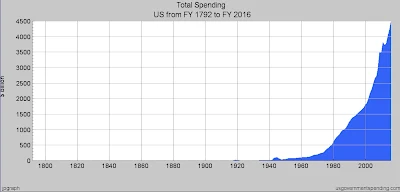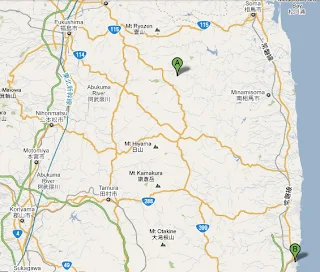Kyodo News here reports that the Japanese government says 66 children checked in Kawamata (B) are not in danger of thyroid problems from radiation exposure from the crippled nuclear reactors (A).
The passing scene is hilarious, until it careens through the front yard and crashes into my living room.
Thursday, March 24, 2011
Workers Laying Cable at Fukushima Reactor 3 Injured by Radioactive Puddle
Kyodo News reports here that the workers had on Tyvek suits but no boots and stepped into a 15cm puddle of water which threw off 200 to 400 millisieverts of radiation per hour and caused beta ray burns to the feet of two of the men Thursday morning Tokyo time.
So far 17 workers each have been exposed to over 100 millisieverts of radiation since the trouble began at Fukushima.
Wednesday, March 23, 2011
America's Number One Nuclear Problem is Spent Fuel Storage
So says Robert Alvarez for The Los Angeles Times:
[T]he nation's 104 nuclear power plants are legally storing spent fuel in onsite cooling ponds much longer, and at higher densities (on average four times higher), than was originally intended. And now that the Obama administration has called off proposed plans to store nuclear waste at the Yucca Mountain site in Nevada, fuel is likely to remain at the plants where it was used for decades to come.
This presents a serious threat. Our report found that, as in Japan, US nuclear safety authorities don't require reactor operators to have backup power supplies to circulate water in the pools and keep them cool if there is a loss of offsite power. ...
[A] severe pool fire could render about 188 square miles uninhabitable, cause as many as 28,000 cancer fatalities and cost $59 billion in damage.
Read all of it here.
Fukushima City Radiation Tuesday Evening 10 Times the US Normal Level
So Kyodo News here:
[T]he radiation dose detected in Fukushima Prefecture stood at 6.85 microsieverts per hour in the city of Fukushima at 7 p.m. Tuesday, the Fukushima prefectural government said. The dose is gradually receding in the area, it added.
At that rate one would be exposed to 60 millisieverts in one year. Normal in the US is about 6 millisieverts per year.
Based on data plugged into a computer model, the article speculates that certain individuals even outside 30 kilometers of the plant could have been exposed to 100 millisieverts since the tsunami.
About a week ago levels in the city stood at 20 microsieverts per hour, so observations are trending lower already 66 percent.
Fukushima Reactor 2 Radiation 500 mSv/hour Since Friday
As reported by Kyodo News here:
At the No. 2 reactor, workers have been unable to replace some parts to help revive its internal cooling systems since Friday as high-level radiation amounting to at least 500 millisieverts per hour was detected at its turbine building, the spokesman also said.
The equivalent in an hour of a lifetime's worth of radiation.
A Woman Decides Her Husband is Right: Women are Nuts
Her name is Heather Wilhelm:
"Men may be jerks," my husband likes to occasionally declare, "but women are insane." I hate to admit it, but he's right-and anyone who has spent two years living in a sorority house filled with alpha girls (I'm raising my hand) can attest that this is true.
Women are likely going nuts for a number of reasons. For instance, it's quite tiring and stressful, not to mention impossible, to try to have the brilliant job, the perfect family, shiny hair and manicured hands. Some women say they want total "equality" but still want guys to pick up the check. But perhaps another reason women are losing it is that they're repeatedly told that they're no different than men-and many believe it, particularly in the realm of sex.
This, of course, is clearly not true.
In other words, only the woman has the instincts to make a family perfect and all the "child men" are their fault, "with all my worldly goods I thee endow" for sex is a no brainer that proves men are inferior, and bearing children trumps making them.
You can read the rest here.
Tuesday, March 22, 2011
TEPCO Says Radiation Drops Near Fukushima Reactor Main Gate
Company officials told reporters that the radiation level near the plant's gate 1 kilometer west of the reactors was up to 1,932 microsieverts per hour at 6:30 PM on Monday.
By midnight, the figure had dropped to 331.8, and by 10 AM on Tuesday, it was down to 260.2 microsieverts per hour.
Normal in the US is less than 0.71 microsieverts per hour.
Read more at NHK World here.
Monday, March 21, 2011
Iodine 131, Cesium 134, Cesium 137, Cobalt 58 All Found in Sea Water Near Fukushima
As reported here:
According to TEPCO, radioactive iodine-131 was detected Monday in the seawater samples at levels 126.7 times higher than the legal concentration limit. Levels of cesium-134 were 24.8 times higher and those of cesium-137 16.5 times higher while a trace amount of cobalt 58 was detected in a sample of seawater taken from near the plant.
Radiation in Namie, Japan
Kyodo News reports here that radiation levels in Namie (B), 20 km north of the Fukushima Nuclear Plant (A), are 161 microsieverts per hour.
It would take just under 26 days of continuous exposure to such levels to accumulate 100 millisieverts of radiation exposure, and in a year over 1,400 mSv.
Devra Davis for Reuters, here, puts that in its health context:
In terms of cumulative exposure, 100 millisieverts a year is the lowest level at which any increase in cancer risk is clearly evident. A cumulative 1,000 mSv over a lifetime would be expected to cause a fatal cancer many years later in five out of every 100 persons with that kind of exposure.
Multiculturalism As It Was Meant To Be, Illustrated
Bruce Thornton on Islam, here:
Muslims have a religious world-view and sensibility that condition their actions and interests, and we must understand those spiritual beliefs in their own terms rather than reducing them to the materialist determinism that dominates our thinking.
Sage Advice
Hermit hoar, in solemn cell,
Wearing out life's evening gray,
Smite thy bosom, sage, and tell,
Where is bliss? and which the way?
Thus I spoke, and speaking sighed--
Scarce repressed the starting tear--
When the smiling sage replied,
'Come, my lad, and drink some beer'.
-- Samuel Johnson --
Main Radiation Effects at Fukushima I From No. 4 Spent Fuel Cooling Pond
So says Tony Irwin of the Australian National University for France24 here:
"Reactors 5 and 6, they are now in what's called cold shutdown, and the spent fuel cooling ponds are at normal temperatures.
"They are in the sort of situation now we would like to see 1, 2, 3 and 4 in.
"There was already spent fuel in there [before No. 4 was drained and emptied last November] so there was quite a high load of spent fuel in that pond. And that has been giving the main radiation effects on site."
One presumes from that that the high heat coming off the pond kept boiling away the water during the crisis and not that an earthquake related leak in the pond kept drawing down the level.
For the first time I read in the article a concern about all the sea water being poured on the stricken reactors because it thereby becomes radioactive waste.
Where is it all going, ton after ton? To air and back to sea?
Undoubtedly.
One presumes from that that the high heat coming off the pond kept boiling away the water during the crisis and not that an earthquake related leak in the pond kept drawing down the level.
For the first time I read in the article a concern about all the sea water being poured on the stricken reactors because it thereby becomes radioactive waste.
Where is it all going, ton after ton? To air and back to sea?
Undoubtedly.
Radiation Level at Iitate, Japan
Breitbart reports here that a monitor in Iitate, Japan (A), thirty miles northwest of Fukushima I (B), recorded the highest radiation sample recently taken from 12 monitoring stations in the area: 12.1 microsieverts per hour.
That would be 290.4 microsieverts per 24 hour day, or a normal annual dose in America of 6,200 microsieverts in just 21 days.
The rate per hour of 12.1 microsieverts is over 17 times the normal rate in America of .70776 microsieverts per hour.
Smoke at Fukushima But No Reported Change in Radiation Levels
Kyodo News has the latest update here, with the following related information:
[O]ne of seven workers who were injured following a March 14 hydrogen explosion at the No. 3 reactor was found to have been exposed to radiation amounting to over 150 millisievert per hour.
The level is lower than the maximum limit of 250 millisievert per hour set by the health ministry for workers tackling the emergency at the Fukushima plant.
An emergency worker in the US is permitted a once in a lifetime maximum single exposure of 250 mSv. Added to normal radiation exposure over the course of a lifetime, such exposure raises lifetime totals from a normal 484 mSv to 734 mSv, 52 percent more than normal.
Supreme Court Rejects 8 Bank Clearing House Appeal on Loan Disclosures
The decision, which is moot as to future disclosure requirements because of the disclosure requirements under the Dodd-Frank legislation, will require that the Federal Reserve disclose loans made at the discount window in 2008. The story, excerpted below, is reported by Bloomberg here:
The order marks the first time a court has forced the Fed to reveal the names of banks that borrowed from its oldest lending program, the 98-year-old discount window. The disclosures, together with details of six bailout programs released by the central bank in December under a congressional mandate, would give taxpayers insight into the Fed’s unprecedented $3.5 trillion effort to stem the 2008 financial panic.
Sunday, March 20, 2011
Radiation Update, Fukushima I Reactor 2
Dateline Tokyo for March 20th, 2011, as reported here by Kyodo News:
Meanwhile, a total of 40 tons of seawater was pumped into the spent fuel tank of the No. 2 unit, using a makeshift power source.
The radiation level inside the plant is on a declining trend. At about 0.5 kilometer northwest from the No. 2 reactor, the level dropped to 2,830 microsievert per hour as of 4:30 p.m., compared to 3,443 microsievert per hour at 2 p.m. Saturday.
In millisieverts, the level has dropped from 3.443 mSv/hour to 2.830 mSv/hour according to this report. At this lower rate it would take just over one week if continuously present to be exposed to a lifetime's worth of normal radiation at the location specified.
Any volunteers?
Saturday, March 19, 2011
Subscribe to:
Posts (Atom)





